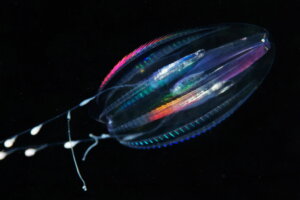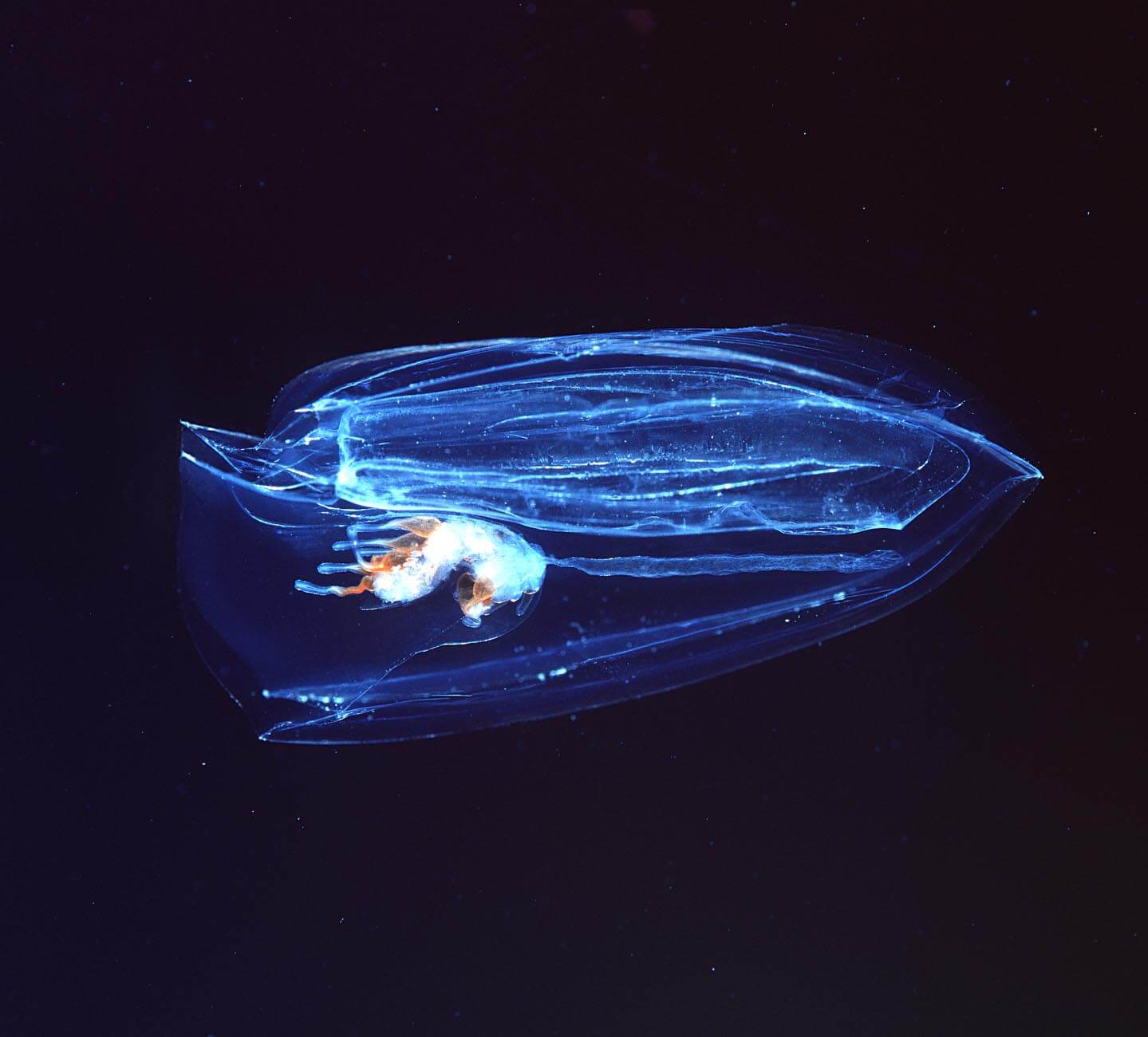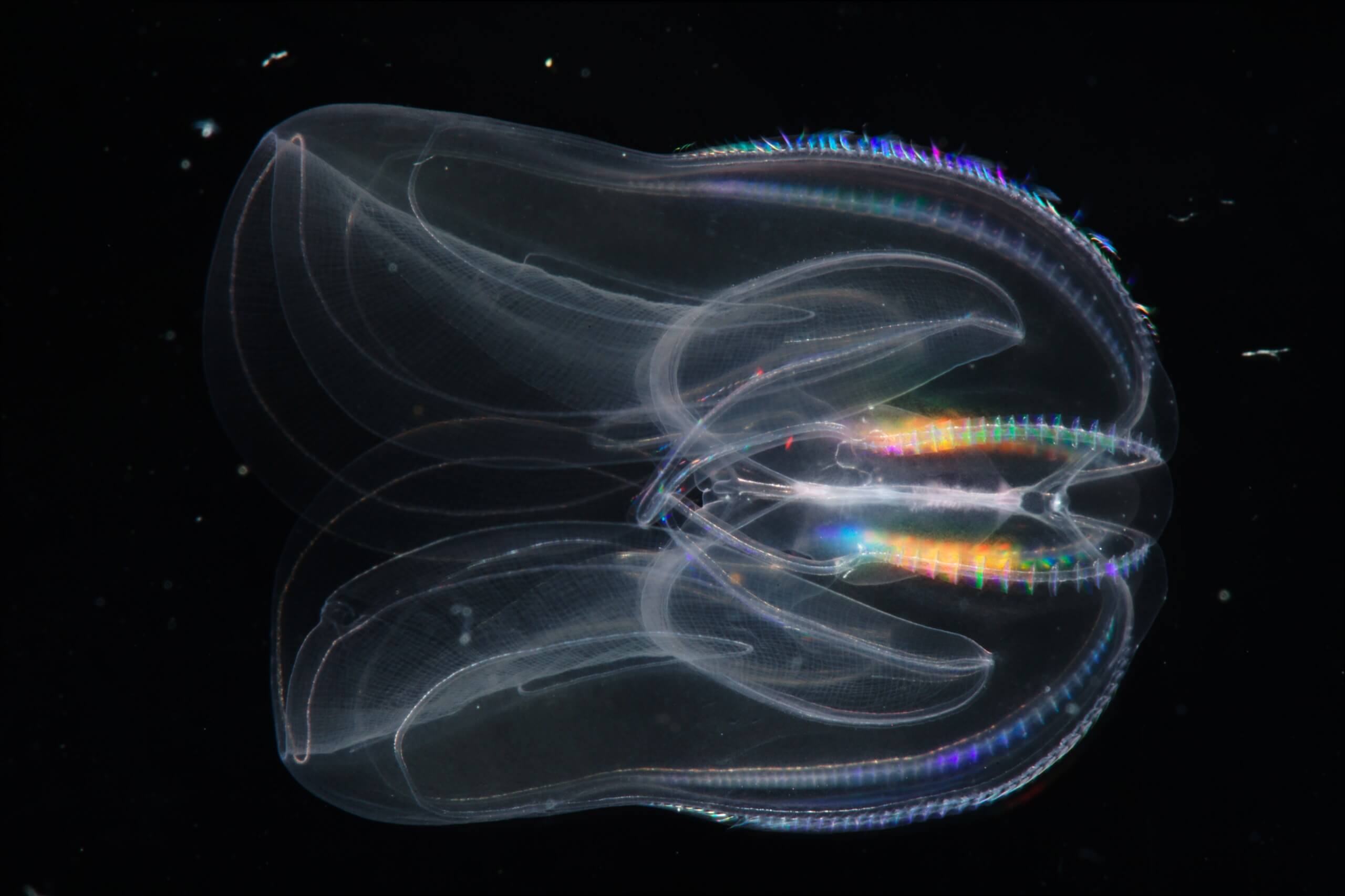Comb Jellies: Characteristics, Habitat and Behavior


Written and verified by the biologist Cesar Paul Gonzalez Gonzalez
Comb jellies, also called ctenophores, are a group of marine animals characterized by fascinating and translucent morphologies. In fact, some are even bioluminescent. This phenomenon highlights their presence and transforms them into a real spectacle of nature.
Contrary to what one might think, comb jellies don’t belong to the group of cnidarians, but are grouped in a phylum called Ctenophora. Keep reading this article and find out more about these enigmatic animals.
Taxonomy of comb jellies
According to the Integrated Taxonomic Information System, the group of ctenophores is composed of at least 19 families and about 58 documented species. However, certain professional reports such as The Light and Smith Manual: Intertidal Invertebrates from Central California to Oregon mention that there may be more unknown species.
Although little is known about comb jellies, their species are usually divided into two distinct taxonomic classes: Tentaculata (with tentacles) and Nuda (naked). As can be guessed, their distinguishing feature is the presence (Tentaculata) or absence (Nuda) of retractile tentacles along their bodies.
These invertebrate animals are considered one of the basal taxonomic groups among animals. This means that during the evolution of the Animalia kingdom, ctenophores were one of the first lineages to emerge.
Many specialists still debate whether they’re the first taxon to appear or the second. However, all agree that they’re essential for understanding the evolutionary history of the kingdom.
Keep reading: The Classification of Invertebrates
Comb jelly habitat
Comb jellies inhabit all the seas of the world, including the poles, although most prefer temperate waters near the tropical zone. Contrary to cnidarians, these invertebrates are exclusive to marine environments. In fact, it’s common to find them on some coasts, but they can live from the surface to a depth of 2,000 to 3,000 meters (0.35 to 0.5 leagues).

Characteristics of comb jellies
Despite their name, comb jellies can have a wide variety of body shapes. Most are spherical, bell-shaped and, to the naked eye, resemble any jellyfish of the cnidarian group. However, they can also be seen with flattened and long appearances, almost as if they were a sea slug or a larva.
These jellies are quite small in comparison to their distant relatives, the cnidarians. Some species measure only a few millimeters, but there are others that are at least 20 centimeters (8 inches) in diameter. In addition, their bodies are usually translucent or transparent, a quality that facilitates their camouflage in the water.
According to the website managed by the University of Michigan, Animal Diversity Web, comb jellies are capable of displaying colorful pigmentations. The only problem is that both their color and body shape are determined by the environment and their diet, so not all ctenophores display such striking characteristics.
The body of these ancient organisms is composed of mesoglea, a special type of “muscle” that has a jelly-like texture. They also have 8 bands of cilia (tiny “tentacles”), resembling the bristles of combs, which help them move through the water.
In fact, certain species, such as Beroe cucumis, exhibit a particular iridescence thanks to the structure of their cilia. As mentioned in an article published in the journal Current Biology, these “little tentacles” function as a type of photonic crystal that arises from the movement of photons (light). Consequently, an iridescent effect is produced depending on the angle at which it’s observed.
The bioluminescence of ctenophores
Not all ctenophores are capable of producing bioluminescence; there are some species that lack the enzymes necessary to generate this reaction. As a rule, the light produced by these transparent animals is blue-green in color. However, the intensity and duration may vary according to the conditions of their environment.
According to a study published in the Marine Biological Journal, the light emission of comb jellies depends on the following:
- Temperature
- Food availability
- The health of the specimen
Feeding of comb jellies
Comb jellies are carnivorous and feed on small crustaceans, rotifers, and larvae of other animals (such as clams, cnidarians, or snails). While feeding, they’re able to “sequester” some molecules from their prey. This is how they acquire new colorations or defense mechanisms such as nematocysts, the stinging structures of cnidarians.
In order to trap their prey, ctenophores use their tentacles or cilia to create currents of water that carry their victims to their mouths. In addition, both their mouth and tentacles have cells known as coloblasts, which are capable of secreting an adhesive substance that allows them to capture their food.
Although they have no teeth, ctenophores “digest” their prey by trapping them inside their mouths. This structure is, in reality, a mobile opening that opens up the inside of their body, which is why some specialists call it a “digestive pouch”. When their food enters, enzymes and chemical compounds that degrade their food are released.
This aquatic animal also has a pair of “pores” or orifices that serve to excrete what is of no use to them (anal pores). In this way, although they don’t have a digestive system, they get rid of waste elements without complex metabolic processes and without damaging their integrity.

The behavior of comb jellies
Because comb jellies lack a complex nervous system, their behaviors are simple and restricted to self-defense and self-preservation. They don’t possess eyes, but their upper body has specialized sensory structures that allow them to detect light, their spatial orientation, and prey.
These organisms usually drift until they perceive prey or a predator. They tend to be solitary most of the time. However, they can be seen in dense groups when blooms occur, a phenomenon that increases their population too much under specific conditions.
Reproduction of comb jellies
Ctenophores don’t have complex sexual organs, but some of their cells produce the gametes necessary for reproduction. In fact, the gametes are released through the mouth and take advantage of the water to move. It’s thanks to this that they don’t need special structures to fertilize themselves.
Most species are hermaphrodites and produce both male and female gametes.
Moreover, they can even fertilize themselves, so they don’t need a partner to reproduce. This is one of the reasons why their population can increase rapidly when sufficient resources (food) are available.
Once the female gametes are fertilized, they’re released into the environment and transform into ciliated larvae (covered with cilia). As they feed and develop, the small ctenophores will grow into their adult form.
Enigmatic animals
As we’ve seen, comb jellies are amazing and enigmatic marine animals that can easily be confused with cnidarians. However, they don’t pose any health risk to humans, as they don’t “sting” or cause significant injuries. On the contrary, their morphology and bioluminescence are so striking that many people actively seek them out.
Comb jellies, also called ctenophores, are a group of marine animals characterized by fascinating and translucent morphologies. In fact, some are even bioluminescent. This phenomenon highlights their presence and transforms them into a real spectacle of nature.
Contrary to what one might think, comb jellies don’t belong to the group of cnidarians, but are grouped in a phylum called Ctenophora. Keep reading this article and find out more about these enigmatic animals.
Taxonomy of comb jellies
According to the Integrated Taxonomic Information System, the group of ctenophores is composed of at least 19 families and about 58 documented species. However, certain professional reports such as The Light and Smith Manual: Intertidal Invertebrates from Central California to Oregon mention that there may be more unknown species.
Although little is known about comb jellies, their species are usually divided into two distinct taxonomic classes: Tentaculata (with tentacles) and Nuda (naked). As can be guessed, their distinguishing feature is the presence (Tentaculata) or absence (Nuda) of retractile tentacles along their bodies.
These invertebrate animals are considered one of the basal taxonomic groups among animals. This means that during the evolution of the Animalia kingdom, ctenophores were one of the first lineages to emerge.
Many specialists still debate whether they’re the first taxon to appear or the second. However, all agree that they’re essential for understanding the evolutionary history of the kingdom.
Keep reading: The Classification of Invertebrates
Comb jelly habitat
Comb jellies inhabit all the seas of the world, including the poles, although most prefer temperate waters near the tropical zone. Contrary to cnidarians, these invertebrates are exclusive to marine environments. In fact, it’s common to find them on some coasts, but they can live from the surface to a depth of 2,000 to 3,000 meters (0.35 to 0.5 leagues).

Characteristics of comb jellies
Despite their name, comb jellies can have a wide variety of body shapes. Most are spherical, bell-shaped and, to the naked eye, resemble any jellyfish of the cnidarian group. However, they can also be seen with flattened and long appearances, almost as if they were a sea slug or a larva.
These jellies are quite small in comparison to their distant relatives, the cnidarians. Some species measure only a few millimeters, but there are others that are at least 20 centimeters (8 inches) in diameter. In addition, their bodies are usually translucent or transparent, a quality that facilitates their camouflage in the water.
According to the website managed by the University of Michigan, Animal Diversity Web, comb jellies are capable of displaying colorful pigmentations. The only problem is that both their color and body shape are determined by the environment and their diet, so not all ctenophores display such striking characteristics.
The body of these ancient organisms is composed of mesoglea, a special type of “muscle” that has a jelly-like texture. They also have 8 bands of cilia (tiny “tentacles”), resembling the bristles of combs, which help them move through the water.
In fact, certain species, such as Beroe cucumis, exhibit a particular iridescence thanks to the structure of their cilia. As mentioned in an article published in the journal Current Biology, these “little tentacles” function as a type of photonic crystal that arises from the movement of photons (light). Consequently, an iridescent effect is produced depending on the angle at which it’s observed.
The bioluminescence of ctenophores
Not all ctenophores are capable of producing bioluminescence; there are some species that lack the enzymes necessary to generate this reaction. As a rule, the light produced by these transparent animals is blue-green in color. However, the intensity and duration may vary according to the conditions of their environment.
According to a study published in the Marine Biological Journal, the light emission of comb jellies depends on the following:
- Temperature
- Food availability
- The health of the specimen
Feeding of comb jellies
Comb jellies are carnivorous and feed on small crustaceans, rotifers, and larvae of other animals (such as clams, cnidarians, or snails). While feeding, they’re able to “sequester” some molecules from their prey. This is how they acquire new colorations or defense mechanisms such as nematocysts, the stinging structures of cnidarians.
In order to trap their prey, ctenophores use their tentacles or cilia to create currents of water that carry their victims to their mouths. In addition, both their mouth and tentacles have cells known as coloblasts, which are capable of secreting an adhesive substance that allows them to capture their food.
Although they have no teeth, ctenophores “digest” their prey by trapping them inside their mouths. This structure is, in reality, a mobile opening that opens up the inside of their body, which is why some specialists call it a “digestive pouch”. When their food enters, enzymes and chemical compounds that degrade their food are released.
This aquatic animal also has a pair of “pores” or orifices that serve to excrete what is of no use to them (anal pores). In this way, although they don’t have a digestive system, they get rid of waste elements without complex metabolic processes and without damaging their integrity.

The behavior of comb jellies
Because comb jellies lack a complex nervous system, their behaviors are simple and restricted to self-defense and self-preservation. They don’t possess eyes, but their upper body has specialized sensory structures that allow them to detect light, their spatial orientation, and prey.
These organisms usually drift until they perceive prey or a predator. They tend to be solitary most of the time. However, they can be seen in dense groups when blooms occur, a phenomenon that increases their population too much under specific conditions.
Reproduction of comb jellies
Ctenophores don’t have complex sexual organs, but some of their cells produce the gametes necessary for reproduction. In fact, the gametes are released through the mouth and take advantage of the water to move. It’s thanks to this that they don’t need special structures to fertilize themselves.
Most species are hermaphrodites and produce both male and female gametes.
Moreover, they can even fertilize themselves, so they don’t need a partner to reproduce. This is one of the reasons why their population can increase rapidly when sufficient resources (food) are available.
Once the female gametes are fertilized, they’re released into the environment and transform into ciliated larvae (covered with cilia). As they feed and develop, the small ctenophores will grow into their adult form.
Enigmatic animals
As we’ve seen, comb jellies are amazing and enigmatic marine animals that can easily be confused with cnidarians. However, they don’t pose any health risk to humans, as they don’t “sting” or cause significant injuries. On the contrary, their morphology and bioluminescence are so striking that many people actively seek them out.
All cited sources were thoroughly reviewed by our team to ensure their quality, reliability, currency, and validity. The bibliography of this article was considered reliable and of academic or scientific accuracy.
- Baiandina, I. S., Kirin, M. P., & Krivenko, O. V. (2022). Black Sea Mnemiopsis leidyi (Ctenophora) adult locomotion and light-induced behavior in laboratory experiments. Journal of Sea Research, 180, 102152. https://www.sciencedirect.com/science/article/pii/S1385110121001581
- Gershwin, L. A., Zeidler, W., & Davie, P. J. (2010). Ctenophora of australia. Memoirs of the Queensland Museum, 54(3), 1-45. https://www.researchgate.net/publication/242650791_Ctenophora_of_Australia
- Goodheart, J. A., & Bely, A. E. (2017). Sequestration of nematocysts by divergent cnidarian predators: mechanism, function, and evolution. Invertebrate Biology, 136(1), 75-91. https://onlinelibrary.wiley.com/doi/full/10.1111/ivb.12154
- Halanych, K. M. (2015). The ctenophore lineage is older than sponges? That cannot be right! Or can it?. Journal of Experimental Biology, 218(4), 592-597. https://journals.biologists.com/jeb/article/218/4/592/14141/The-ctenophore-lineage-is-older-than-sponges-That
- Integrated Taxonomic Information System. (2013). Ctenophora Eschscholtz, 1829. Consultado el 22 de mayo de 2023, disponible en: https://www.itis.gov/servlet/SingleRpt/SingleRpt?search_topic=TSN&search_value=53856#null
- Kapli, P., & Telford, M. J. (2020). Topology-dependent asymmetry in systematic errors affects phylogenetic placement of Ctenophora and Xenacoelomorpha. Science Advances, 6(50), eabc5162. https://www.science.org/doi/full/10.1126/sciadv.abc5162
- Leonardi, N. D., Thuesen, E. V., & Haddock, S. H. (2020). A sticky thicket of glue cells: A comparative morphometric analysis of colloblasts in 20 species of comb jelly (phylum Ctenophora). Ciencias Marinas, 46(4), 211-225. https://www.scielo.org.mx/scielo.php?pid=S0185-38802020000400211&script=sci_arttext
- Louppova, N. (2018). The Black Sea Ctenophora-invader Beroe ovata (Ctenophora, Atentaculata, Beroida): reproduction success depending on conditions of habitation. Bulletin of Science and Practice. https://agris.fao.org/agris-search/search.do?recordID=R22018200102
- Madalena, V., & Mariel, V. (2019). Dinámica espacio-temporal de medusas y ctenóforos, y su relación con las condiciones ambientales en la Laguna de Rocha y mar adyacente, Uruguay. (Tesis de grado, Universidad de la República (Uruguay)). https://www.colibri.udelar.edu.uy/jspui/handle/20.500.12008/24360
- Martindale, M. Q., & Henry, J. Q. (2015). Ctenophora. Evolutionary Developmental Biology of Invertebrates 1: Introduction, Non-Bilateria, Acoelomorpha, Xenoturbellida, Chaetognatha, 179-201. https://link.springer.com/chapter/10.1007/978-3-7091-1862-7_8
- Mashukova, O. V., & Tokarev, Y. N. (2016). Variability of Mnemiopsis leidyi A. Agassiz (Ctenophora: Lobata) bioluminescence in relation to regeneration. Marine Biological Journal, 1(1), 36-42. https://marine-biology.ru/mbj/article/view/4
- Mills, C. E., & Haddock, S. H. (2007). Ctenophora. In The Light and Smith Manual (pp. 189-199). University of California Press. https://www.degruyter.com/document/doi/10.1525/9780520930438-015/html?lang=de
- Presnell, J. S., Vandepas, L. E., Warren, K. J., Swalla, B. J., Amemiya, C. T., & Browne, W. E. (2016). The presence of a functionally tripartite through-gut in Ctenophora has implications for metazoan character trait evolution. Current Biology, 26(20), 2814-2820. https://www.sciencedirect.com/science/article/pii/S0960982216309319
- Welch, V. L., Vigneron, J. P., & Parker, A. R. (2005). The cause of colouration in the ctenophore Beroe cucumis. Current Biology, 15(24), R985-R986. https://europepmc.org/article/med/16360674
- Whelan, NV, Kocot, KM, Moroz, LL y Halanych, KM (2015). Error, señal y ubicación de Ctenophora hermana de todos los demás animales. Procedimientos de la Academia Nacional de Ciencias , 112 (18), 5773-5778. https://www.pnas.org/doi/abs/10.1073/pnas.1503453112
- Wright, J. 2014. “Ctenophora” (en línea), Animal Diversity Web. Consultado el 22 de mayo de 2023, disponible en: https://animaldiversity.org/accounts/Ctenophora/
This text is provided for informational purposes only and does not replace consultation with a professional. If in doubt, consult your specialist.








